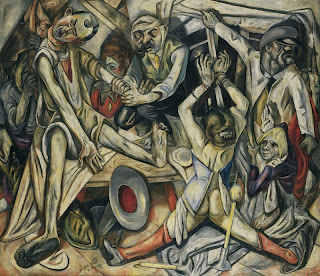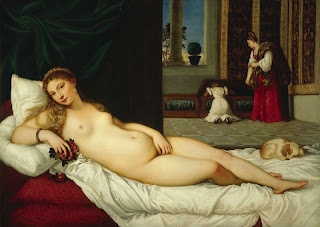Sorry if this post doesn't make any sense. The original got lost in the Blogger crash so I will do my best to reincarnate it.
 Speaking of reincarnation, India, but first, Europe. European have always been know for having great paintings of their oh so loved rulers. When Europe evolved out of the heavily religious ruling of the pre-Renaissance era and into the era of Machiavellian rulers, art had to change with it. It changed from Byzantine mosaics to a rapidly developing desire for portraits. The art of the portrait when through many different phases depending on the times but all of them focused on the power. One of the best examples is the Sun King himself, King Louis XIV. Possibly one of the largest patrons by numbers, Louis commissioned hundreds of paintings, many of himself, and sponsored the state run art academy. This portrait of him by Hyacinthe Rigaud shows the grandeur that was desired in these works. The opulent decorations include a large amount of gold and oversized textile materials. The coronation robes that Louis wears are lifted up to show off his legs that he was very proud off. Along with the material objects in the photo, Louis carries and air of superiority. The portrait is painted from and upward direction and Louis is looking back and down on the viewer.
Speaking of reincarnation, India, but first, Europe. European have always been know for having great paintings of their oh so loved rulers. When Europe evolved out of the heavily religious ruling of the pre-Renaissance era and into the era of Machiavellian rulers, art had to change with it. It changed from Byzantine mosaics to a rapidly developing desire for portraits. The art of the portrait when through many different phases depending on the times but all of them focused on the power. One of the best examples is the Sun King himself, King Louis XIV. Possibly one of the largest patrons by numbers, Louis commissioned hundreds of paintings, many of himself, and sponsored the state run art academy. This portrait of him by Hyacinthe Rigaud shows the grandeur that was desired in these works. The opulent decorations include a large amount of gold and oversized textile materials. The coronation robes that Louis wears are lifted up to show off his legs that he was very proud off. Along with the material objects in the photo, Louis carries and air of superiority. The portrait is painted from and upward direction and Louis is looking back and down on the viewer.
This sense of power and superiority was widespread throughout European royalty. It also managed to travel primarily by way of British Imperialism. As is seen in the portrait of Maharaja Jaswant Singh of Marwar the attitude of the subjects is almost completely different. Though the art of portraiture was adopted, the style was morphed to fit the local cultural influences. Jaswant Singh is portrayed here as a British gentleman next to a table with a simple book and bouquet of flowers. The flat background and simple patterned floor do not exude the same opulence as Louis's portrait. Jaswant Singh is also seated in a relaxed position and looking away from the audience. This accentuates the more humble feel of the work. There are a couple signs of power however in the large emerald necklace that was given to him by a British overlord and the large sword. The riding boots also shows his skill as a hunter. Overall, there is a large contrast between the majority of portraits in 17th century Europe and the portraits in other places like India.
 Speaking of reincarnation, India, but first, Europe. European have always been know for having great paintings of their oh so loved rulers. When Europe evolved out of the heavily religious ruling of the pre-Renaissance era and into the era of Machiavellian rulers, art had to change with it. It changed from Byzantine mosaics to a rapidly developing desire for portraits. The art of the portrait when through many different phases depending on the times but all of them focused on the power. One of the best examples is the Sun King himself, King Louis XIV. Possibly one of the largest patrons by numbers, Louis commissioned hundreds of paintings, many of himself, and sponsored the state run art academy. This portrait of him by Hyacinthe Rigaud shows the grandeur that was desired in these works. The opulent decorations include a large amount of gold and oversized textile materials. The coronation robes that Louis wears are lifted up to show off his legs that he was very proud off. Along with the material objects in the photo, Louis carries and air of superiority. The portrait is painted from and upward direction and Louis is looking back and down on the viewer.
Speaking of reincarnation, India, but first, Europe. European have always been know for having great paintings of their oh so loved rulers. When Europe evolved out of the heavily religious ruling of the pre-Renaissance era and into the era of Machiavellian rulers, art had to change with it. It changed from Byzantine mosaics to a rapidly developing desire for portraits. The art of the portrait when through many different phases depending on the times but all of them focused on the power. One of the best examples is the Sun King himself, King Louis XIV. Possibly one of the largest patrons by numbers, Louis commissioned hundreds of paintings, many of himself, and sponsored the state run art academy. This portrait of him by Hyacinthe Rigaud shows the grandeur that was desired in these works. The opulent decorations include a large amount of gold and oversized textile materials. The coronation robes that Louis wears are lifted up to show off his legs that he was very proud off. Along with the material objects in the photo, Louis carries and air of superiority. The portrait is painted from and upward direction and Louis is looking back and down on the viewer.This sense of power and superiority was widespread throughout European royalty. It also managed to travel primarily by way of British Imperialism. As is seen in the portrait of Maharaja Jaswant Singh of Marwar the attitude of the subjects is almost completely different. Though the art of portraiture was adopted, the style was morphed to fit the local cultural influences. Jaswant Singh is portrayed here as a British gentleman next to a table with a simple book and bouquet of flowers. The flat background and simple patterned floor do not exude the same opulence as Louis's portrait. Jaswant Singh is also seated in a relaxed position and looking away from the audience. This accentuates the more humble feel of the work. There are a couple signs of power however in the large emerald necklace that was given to him by a British overlord and the large sword. The riding boots also shows his skill as a hunter. Overall, there is a large contrast between the majority of portraits in 17th century Europe and the portraits in other places like India.




















